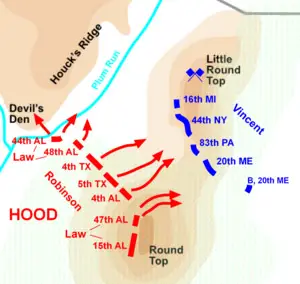 |
The struggle for Little Round Top on the afternoon of July 2 was fought on a rock-strewn, partly wooded hill rising to a height of 650-feet. The peak had been virtually unmanned, except for a Union signal station, throughout the night of the 1st and the morning and afternoon of the 2nd. When the Confederate attack exploded against Maj. Gen. Daniel F. Sickles' III Corps at the Peach Orchard at 4:00 P.M., occupation of the hill suddenly became critical for the army of Maj. Gen. George G. Meade. What followed for nearly 3 hours was a deadly fight for its possession.
Sickles's unauthorized advance to the Peach Orchard had unhinged the Union's left flank. When Meade learned of this movement, he ordered Maj. Gen. George Sykes's V Corps forward and dispatched his Chief of Engineers, Maj. Gen. Gouverneur K. Warren, to reconnoiter on the left. Warren scaled Little Round Top, recognized the peak's importance, found the woods below full of Confederates, and immediately sent a messanger to bring up troops to occupy the hill. Warren's aides located Col. Strong Vincent, who commanded a V Corps brigade, and assuming full responsibility for advancing up the slopes, Vincent double-quicked his 4 regiments. Confederate artillery crews spotted the Federals on the hill and opened fire as the regiments lined Little Round Top's southern and western sides.
Vincent's men had barely settled in when out of the woods to the southwest came 3 Confederate regiments, the 4th Alabama and the 4th and 5th Texas. Thge Union line suddenly erupted in gunfire as the Confederates climbed the slope. Then, on the Union left, where the 20th Maine, under Col. Joshua L. Chamberlain, was positioned, 2 more Confederate regiments stormed across the saddle between the 2 Round Tops. Tired and thirsty, these Confederates, the 15th and 47th Alabama, under Col. William C. Oates, were looking for a fight; in minutes, they would have bargained for.
For the next hour, Chamberlain's 20th maine and Oates's Alabamians slaughtered each other. The Confederates flailed at the Union flanks, repeatedly charging up the slopes, but the Maine soldiers held their rugged line. Around the hill's western slope, the rest of Vincent's regiments repulsed the Confederate charges. Brig. Gen. Stephen H. Weed's brigade soon arrived to lengthen Vincent's right. In the furious combat, Weed was killed, but the Union line held. Chamberlain's stalwart conduct earned him the Medal of Honor. Little Round Top was secured and held throughout the battle by the Federals.



Battle of Little Round Top, initial assault |



Battle of Little Round Top, final assault |
Big Round Top is the southern extremity of the 3-mile long York Haven Diabase sill running from Culp's Hill (625 feet) in the north through Cemetery Hill, Cemetery Ridge, and the Round Tops in the south. These sandstone and granite ridges and hills formed the essence of the Union "fishhook" defensive line on July 2 to July 4, 1863. The Round Tops were privately owned at the time of the battle. Big Round Top was heavily forested and covered with numerous large boulders and rock outcroppings, which made maneuvering military formations difficult at best, and precluded the positioning of any artillery on its crest.
Nevertheless, Confederate Colonel William C. Oates led two regiments of Evander Law's Alabama brigade across the slopes of Big Round Top during his famous assault on the lines of Joshua L. Chamberlain's 20th Maine Infantry on July 2, 1863. Oates' men had been ordered to attack Union troops occupying Devil's Den, but they were forced to move further to the right toward Big Round Top to escape the concentrated Federal artillery fire coming from the Wheatfield and Peach Orchard. Oates had sent off a detachment to locate water for his thirsty men as they climbed the rugged slopes of Big Round Top, but the water bearers became lost in the dense underbrush and woods, and did not rejoin Oates until after the battle. Hence, his two regiments attacked Chamberlain with many soldiers suffering from heat exhaustion and extreme thirst in the hot, humid July weather.
After the fighting ended on July 2, the V Corps brigade of Joseph Fisher occupied a line across the western slope of Big Round Top, facing Oates' tired remnants that were positioned further down the hill. Col. Chamberlain's depleted Maine regiment was sent in the evening to the crest of Big Round Top to recuperate and rest. A small monument now marks their lines.
On July 3, a sharp skirmish occurred in an open D-shaped field on the western slope of Big Round Top. Newly appointed Brig. Gen. Elon J. Farnsworth led his cavalry brigade on a sweeping attack at the Confederate right flank, held by the division of Evander M. Law. Farnsworth's attack failed and he and his men circled back towards the Union lines on nearby Bushman Hill. As Farnsworth's column passed through the cleared field on Big Round Top, Confederate infantrymen killed the young general. Although no monument was ever erected for the slain officer, the 1st Vermont Cavalry did dedicate a monument in the field to their Gettysburg actions.
